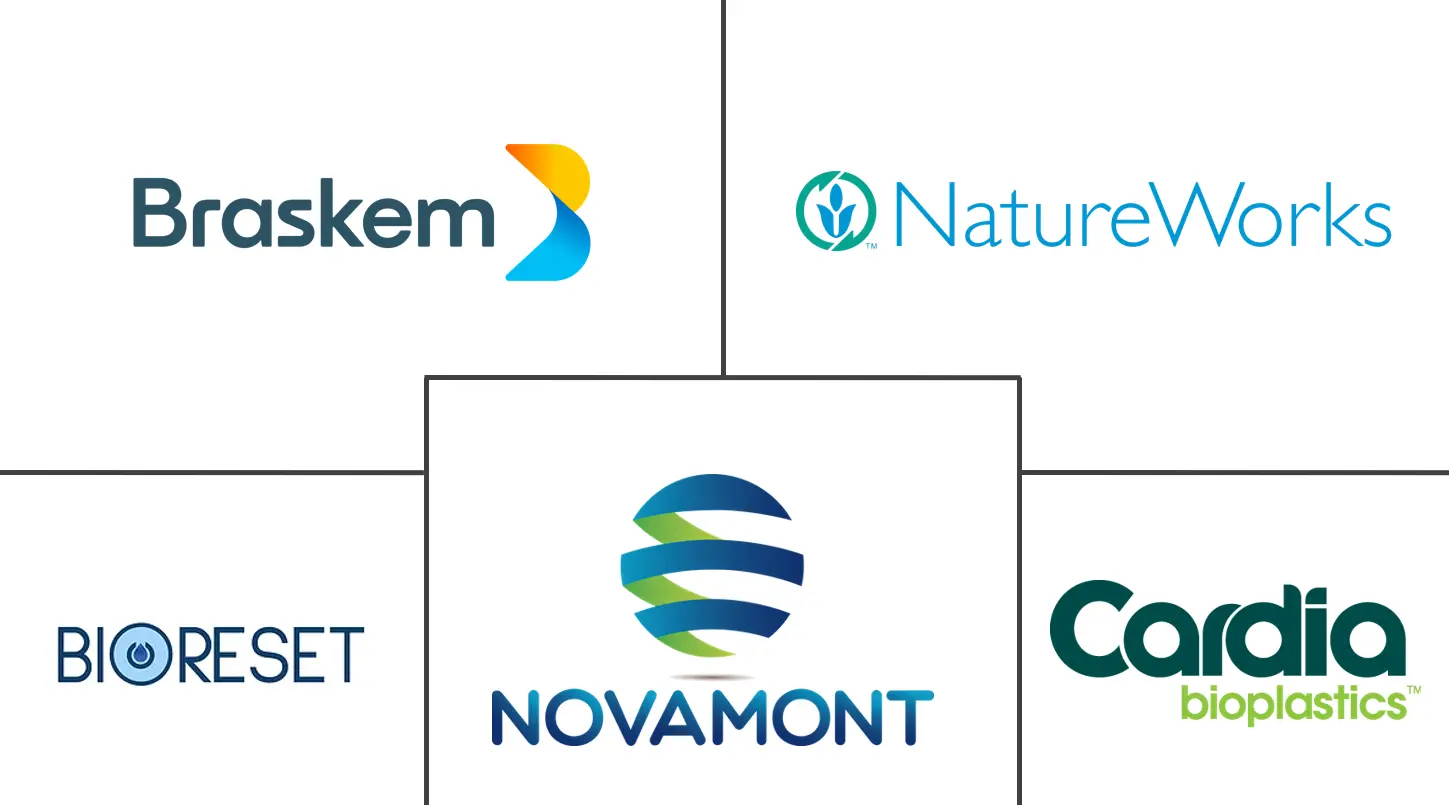Brazil Bioplastics Market Size and Share
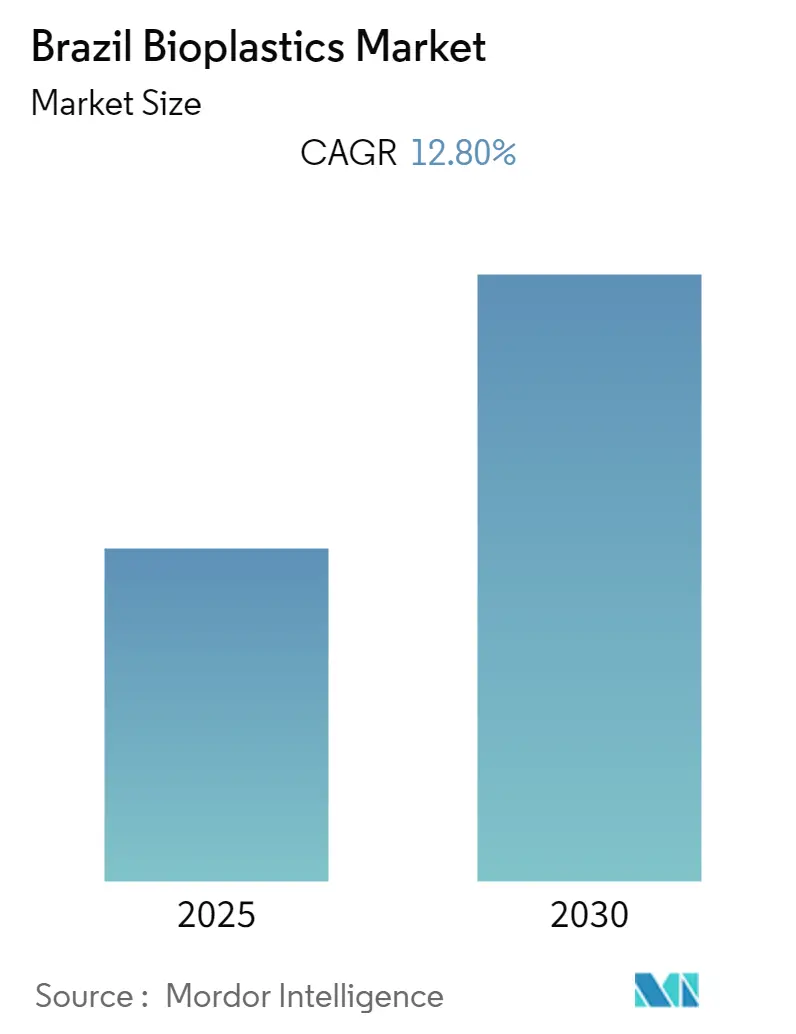
Brazil Bioplastics Market Analysis by Mordor Intelligence
The Brazil Bioplastics Market is expected to register a CAGR of 12.8% during the forecast period.
- The COVID-19 pandemic affected several industries negatively. The lockdown in Brazil caused disruptions in production, as well as industrial activities, and restrictions on freight transportation, disturbed the supply chain. However, the conditions started recovering in 2021, restoring the market's growth trajectory.
- The rising demand from the flexible packaging segment and increasing focus on bioplastics production in Brazil are major factors driving the growth of the market studied.
- However, the availability of cheaper alternatives to traditional plastics is likely to restrain the growth of the studied market.
- Nevertheless, future prospects in non-packaging solutions are likely to create lucrative growth opportunities for the market.
Brazil Bioplastics Market Trends and Insights
Flexible Packaging Industry to Dominate the Market
- Bioplastics are used in flexible packaging, as they are not harmful to nature, and few are easily degradable as well.
- They are used in packaging films for food items, medicines, beverage bottles, packaging films, and packaging of non-food products, such as napkins and tissues, toilet paper, nappies, sanitary towels, cardboard, and coat paper for food wrapping paper, and coated cardboard to make cups and plates. Moreover, they are used in flexible and loose-fill packaging.
- The consumption of bioplastics is increasing in making plastic bags, as they are nature-friendly, and for organic waste collection bags, which are majorly used in hospitals, hotels and restaurants, commercial and retail outlets, and houses.
- Moreover, the food packaging and e-commerce industries have grown tremendously post the onset of COVID-19. The food and beverage industry of the country witnessed significant growth over the past few years. According to the Brazilian Food Industry Association (ABIA), the food industry accounted for 10.8% of the GDP in 2022.
- According to data from the Brazilian Food Processors' Association, Brazil's food processing sector achieved revenue of USD 208 billion in 2022, registering a year-on-year increase of 16.6%.
- The revenue generated from the food and beverage industry of the country is expected to reach around USD 416 million by 2024. Brazil is the second-largest exporter of processed foods in the world. The sector exports to more than 190 countries.
- As for e-commerce, online sales accounted for around 10% of all retail sales in 2022. This is over twice as much as compared to the share of sales before the pandemic. Although e-commerce had been gaining positive momentum in the Brazilian retail market before 2020, the pandemic has accelerated this trend.
- Brazil is amongst the fastest-growing countries in retail e-commerce sales, and 2023 sales are expected to drive beyond the USD 50 billion mark for the first time after consistent growth since 2020.
- With the food and beverage industry growing at a rapid pace and people adopting and preferring online shopping, starting from FMCG products, medicines, electronics, food, and others, the demand for flexible packaging in e-commerce is expected to offer several growth opportunities in the coming years.
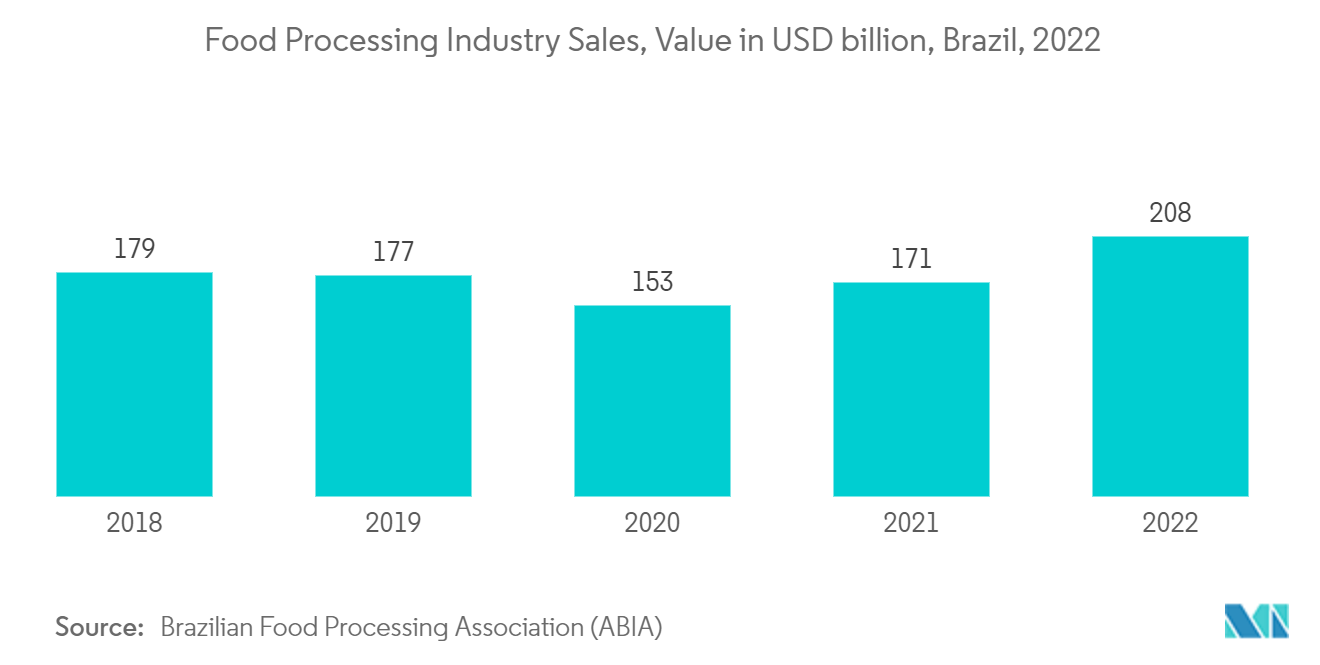
Bio Polyethylene is amongst the Major Product Type in Brazil
- Bio-polyethylene (bio-PE) is a polymer produced from ethanol derived from sugarcane, which is a renewable raw material. It is one of the most popular bio-based plastic. However, unlike bio-PET, it is 100% bio-based. It is used for a wide variety of applications, including single-use bags, cosmetics, soap, and food packaging, as well as packaging films.
- Bio-PE is identical in structure to traditional PE; thus, it can be used in the same way. It is extremely versatile however is most often used in bottles, food packaging, and carrier bags. Bio-PE did not witness much demand, compared to other plastics, largely due to its high price compared to fossil-based PE.
- Bio-PE is not biodegradable. However, it can be recycled within the same chain of recycling fossil-fuel-based polyethylene.
- Bio-PE can be available in the market in different forms, such as high-density polyethylene and linear low-density polyethylene. These high and low-density polyethylene are made by the polyethylene polymerization process of the bio-ethylene monomer.
- Bio-PE can also be used in both rigid and flexible packaging. The different applications of bio-PE include rigid packaging (as bottles and bottle caps), cosmetics and personal care, automotive and transport, agriculture and horticulture, and consumer goods, such as toys.
- Bio-PE was first commercialized by the Brazilian company, Braskem, utilizing local sugarcane-derived ethanol/ethylene as feedstock. In September 2010, Braskem started the commercial production of bio-based HDPE with a capacity of 200 kilotons per year. It is provided under the trademark 'I'm green.'
- In July 2023, Braskem announced that it concluded a 30% increase in the production capacity of its bio-based ethylene plant, located in the Petrochemical Complex of Triunfo, Rio Grande do Sul, Brazil. The USD 87 million investment in the facility was to meet the growing global demand for bio PE. The plant capacity has now increased from 200 kilotons to 260 kilotons yearly.
- Companies such as Procter & Gamble use sugarcane-based high-density polyethylene and HDPE (made by Braskem) in some of their products, such as the Pantene, Covergirl, and MaxFactor brands.
- Therefore, the demand for bio-PE in various applications is expected to increase during the forecast period.
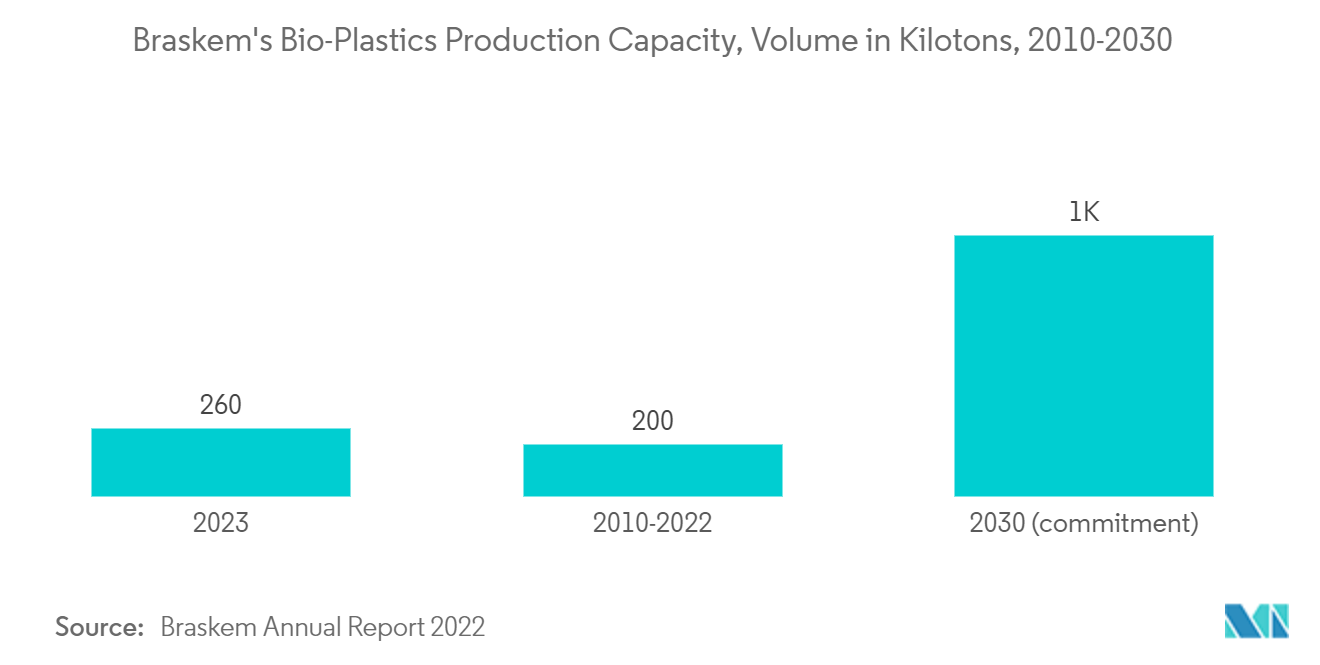
Competitive Landscape
The Brazil Bioplastics Market is partially consolidated in nature. The major players in the market (not in any particular order) include Braskem, Novamont SpA, Natureworks LLC, Bioreset Biotecnologia Ltda, and Cardia Bioplastics, among others.
Brazil Bioplastics Industry Leaders
-
Braskem
-
Cardia Bioplastics
-
Natureworks LLC
-
Bioreset Biotecnologia Ltda
-
Novamont SpA
- *Disclaimer: Major Players sorted in no particular order
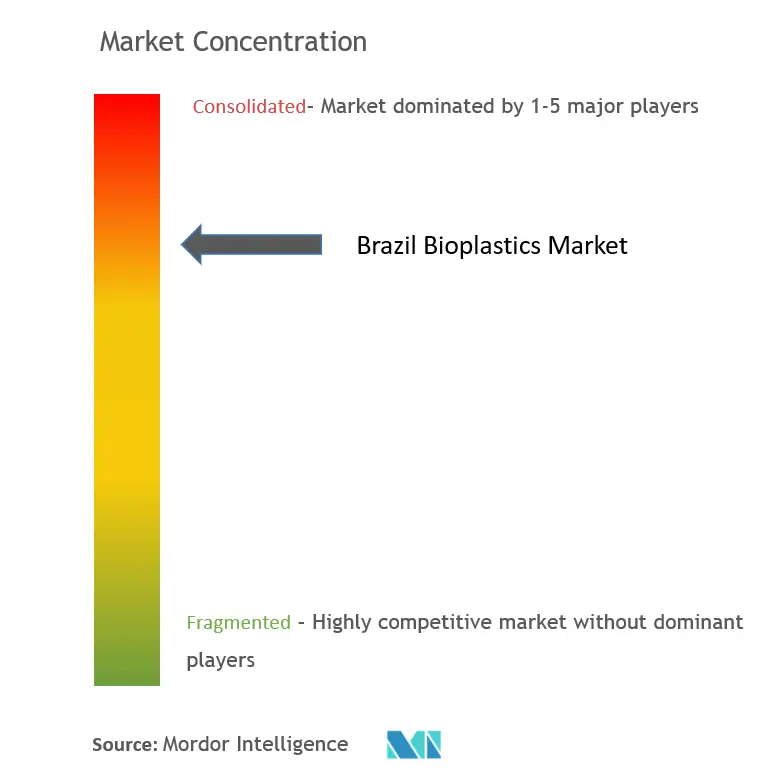
Recent Industry Developments
- October 2022: Braskem announced its plan to expand the production of its I'm greenT biopolymers at its production facility in Brazil. The company is investing an amount of USD 60 million in expanding its I'm green biopolymer production capacity by 30%.
- September 2022: Bioreset invested more than BRL 2 million (0.42 USD million) to develop bioplastics at its production facility installed in Jacareí. The company has set up a pilot plant in partnership with large companies and is preparing to start a facility with a production capacity of more than 100 tons of organic bioplastic pellets starting in 2023.
Brazil Bioplastics Market Report Scope
Bioplastics are plastics produced from renewable sources such as woodchips, sawdust, recycled food waste, corn, and sugarcane, to name a few, and can be used as an alternative to traditional plastics to reduce waste and pollution.
The Brazilian bioplastics market is segmented by type and application. By type, the market is segmented into bio-based biodegradables (starch-based, polylactic acid, polyhydroxyalkanoates, polyesters, and other bio-based biodegradables (polybutylene succinate (Adipate) (PBS(A)) and cellulose-based plastics)) and bio-based non-biodegradables (bio polyethylene terephthalate, bio polyethylene, bio polyamides, bio poly trimethylene terephthalate, and other non-biodegradables (polyethylenefuranoate (PEF), bio polyols, bio polypropylene, and bio polyurethanes)). By application, the market is segmented into flexible packaging, rigid packaging, automotive and assembly operations, agriculture and horticulture, construction, textiles, electrical and electronics, and other applications (coatings, adhesives, consumer goods, and healthcare).
For each segment, the market sizing and forecasts are provided on the basis of volume (tons).
| Bio-based Biodegradables | Starch-based |
| Polylactic Acid (PLA) | |
| Polyhydroxy Alkanoates (PHA) | |
| Polyesters (PBS, PBAT, and PCL) | |
| Other Bio-based Biodegradables (Polybutylene Succinate (Adipate) (PBS(A)) and Cellulose-based Plastics) | |
| Bio-based Non-biodegradables | Bio Polyethylene Terephthalate (PET) |
| Bio Polyethylene | |
| Bio Polyamides | |
| Bio Polytrimethylene Terephthalate | |
| Other Non-biodegradables (Polyethylenefuranoate (PEF), Bio Polyols, Bio Polypropylene and Bio Polyurethanes) |
| Flexible Packaging |
| Rigid Packaging |
| Automotive and Assembly Operations |
| Agriculture and Horticulture |
| Construction |
| Textiles |
| Electrical and Electronics |
| Other Applications (Coatings, Adhesives, Consumer Goods, and Healthcare) |
| Type | Bio-based Biodegradables | Starch-based |
| Polylactic Acid (PLA) | ||
| Polyhydroxy Alkanoates (PHA) | ||
| Polyesters (PBS, PBAT, and PCL) | ||
| Other Bio-based Biodegradables (Polybutylene Succinate (Adipate) (PBS(A)) and Cellulose-based Plastics) | ||
| Bio-based Non-biodegradables | Bio Polyethylene Terephthalate (PET) | |
| Bio Polyethylene | ||
| Bio Polyamides | ||
| Bio Polytrimethylene Terephthalate | ||
| Other Non-biodegradables (Polyethylenefuranoate (PEF), Bio Polyols, Bio Polypropylene and Bio Polyurethanes) | ||
| Application | Flexible Packaging | |
| Rigid Packaging | ||
| Automotive and Assembly Operations | ||
| Agriculture and Horticulture | ||
| Construction | ||
| Textiles | ||
| Electrical and Electronics | ||
| Other Applications (Coatings, Adhesives, Consumer Goods, and Healthcare) | ||
Key Questions Answered in the Report
What is the current undefined size?
The undefined is projected to register a CAGR of 12.8% during the forecast period (2025-2030)
Who are the key players in undefined?
Braskem, Cardia Bioplastics, Natureworks LLC, Bioreset Biotecnologia Ltda and Novamont SpA are the major companies operating in the undefined.
What years does this undefined cover?
The report covers the undefined historical market size for years: 2019, 2020, 2021, 2022, 2023 and 2024. The report also forecasts the undefined size for years: 2025, 2026, 2027, 2028, 2029 and 2030.
Page last updated on:
Brazil Bioplastics Market Report
Statistics for the 2025 Brazil Bioplastics market share, size and revenue growth rate, created by Mordor Intelligence™ Industry Reports. Brazil Bioplastics analysis includes a market forecast outlook for 2025 to 2030 and historical overview. Get a sample of this industry analysis as a free report PDF download.
